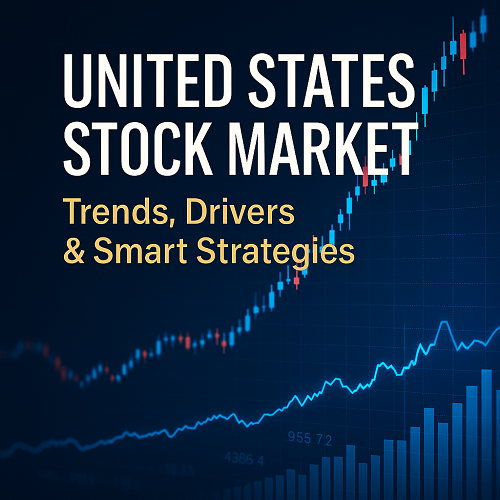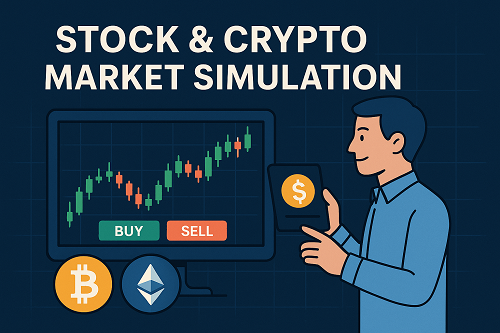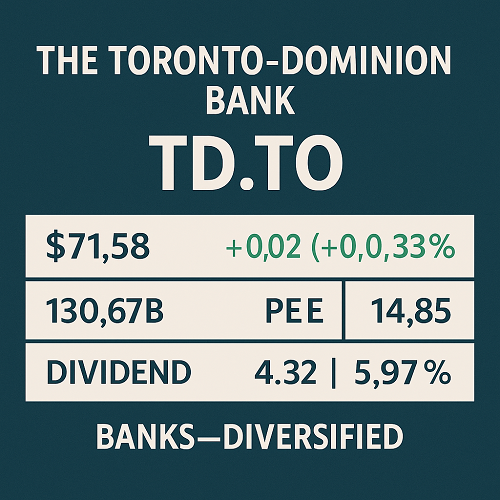The U.S. stock market continues to be among the most closely watched globally. According to Trading Economics, the U.S. “Stock Market Index” (CFD-based composite) stood at approximately 6,664 points on 17 October 2025, up about 0.53% for the session.
Over the past month the index rose ~0.48%, and year-on-year the gain is about 13.63%.
Another data point: The “US30” index (reflecting the Dow Jones Industrial Average) traded at ~46,229 on 17 October, up ~0.52% that day.
Why this matters
- These numbers indicate the market remains in a bull phase, though gains are modest in the short term.
- Year-on-year strength >10% suggests investor confidence remains intact.
- However, the modest monthly gain signals possible consolidation or caution setting in.
- For traders, this means: opportunity remains, but risk management is key.
Charting the trend
Having a visual of long-term trend helps:
6
Key takeaways from the chart:
- The market has recovered strongly post the 2020 pandemic trough.
- The recent years show sharp advances in tech/AI-related stocks.
- The uptrend is intact, but slope is flattening → implies consolidation could follow.
Macro Drivers Shaping the U.S. Stock Market
Understanding the major forces behind market moves gives traders a decisive edge.
Monetary policy & interest rates
- The Federal Reserve remains a central influence. Elevated interest rates increase discount rates, which negatively impact equities—especially high-growth stocks.
- Trading Economics’ forecast for the U.S. Stock Market Index shows interest rates at ~4.25% in Q3-25, then gradually declining to ~3.50% by Q2-26.
- Implication: If rates fall, equities (especially growth) may rally; if inflation forces rises, expect pressure.
Inflation, growth & employment
- Inflation expectations still hover around ~3% annually in many forecasts.
- Strong employment supports corporate earnings, but if labour costs escalate too much, margins may be squeezed.
- Growth is uneven: the U.S. economy remains resilient, but many analysts warn about divergence between consumer strength and business investment.
Trade & geopolitics
- U.S. trade policy, tariffs, and international tensions can act as triggers for sharp equity moves. As seen earlier in 2025, trade jitters caused market volatility.
- Traders should monitor: U.S.–China relations, supply-chain disruptions, raw material inflation, and regulatory shifts.
Sector innovation: AI, tech & disruption
- One of the major drivers of the recent rally is the growth of AI-related businesses. As reported: “The U.S. stock market continues reaching record highs, driven largely by enthusiasm around artificial intelligence (AI).”
- Major technology companies dominate the index weightings—so structural shifts in tech impact the entire market.
Sentiment & flows
- Markets are forward-looking; investor sentiment, hedge-fund positioning, retail participation and ETF flows all matter.
- When sentiment turns overly bullish, risk of correction rises; when overly bearish, opportunity arises.
Sector Breakdown: Winners, Laggards & Rotation
Winner sectors
- Technology & AI infrastructure: mega-caps continue to lead, given the investment wave in generative AI and cloud infrastructure.
- Healthcare & biotech: defence against broader cyclical weakness; innovation pipelines matter.
- Energy and materials: as inflation and raw commodity prices rise, these sectors benefit—though they face cyclicality.
Laggard sectors
- Consumer discretionary: especially those reliant on low-cost manufacturing overseas may struggle with tariffs and weak consumer sentiment.
- Traditional bricks-and-mortar retail: under pressure from e-commerce and cost inflation.
- Financials (regional banks): under stress if loan loss provisions rise or credit conditions deteriorate.
Sector rotation signals
- If interest rates begin to decline → growth stocks (tech) tend to outperform.
- If inflation or raw-material prices spike → value sectors (energy, materials) may outperform.
- Keeping tabs on sector flows provides early signals for rotation.
Interplay: Stocks, Forex & Cryptocurrencies
An advanced trader recognizes that stocks don’t move in isolation: currencies and crypto markets often provide edge.
Stocks ↔ Forex
- A stronger U.S. dollar tends to weigh on U.S. multinationals’ earnings (via translation losses) and may make U.S. exports less competitive.
- Conversely, a weaker dollar can boost commodities and multinational earnings.
- Charts show USD strength currently:
6
- For example, when the U.S. enters a risk-off phase, we often see: equities down → dollar up → commodities down. Recognizing that pattern helps position across asset classes.
Stocks ↔ Cryptocurrencies
- Though crypto is not a perfect hedge, in periods of strong risk appetite equities and crypto often rally together.
- In risk-off phases, both may sell off—but crypto can react earlier to sentiment shifts.
- Monitoring crypto flows can act as a leading indicator for broader risk appetite; for example, sharp crypto declines may hint equity weakness ahead.
Multi-asset strategy
- Consider using pairs trades: e.g., long equity, short USD (if expecting rate cuts).
- Or: long value sector equities + long commodities + short high-growth tech (if expecting inflation spike).
- Use currency and crypto indicators to confirm or reject equity bias.
Risk Factors & Red Flags
No overview would be complete without highlighting what could derail the up-trend.
Valuation risk
- With the S&P 500 and other indices near record highs, the margin for error is narrower. Investors must ask: Are we paying for future growth that may not materialize?
- Over-concentration in mega-cap tech creates vulnerability to sector-specific shocks.
Rate & inflation reversal
- If inflation re-accelerates, the Fed may raise rates unexpectedly → discount rates rise → equities suffer.
- A rapid rate-cut scenario also risks: if it reflects economic weakness rather than proactive policy.
Geopolitical / trade shocks
- Trade wars, supply-chain shocks (e.g., semiconductors), war-related disruptions, and regulatory clamp-downs (technology, data) remain potent risks.
Corporate earnings disappointment
- High earnings expectations are embedded in valuations. Misses (especially in growth sectors) could trigger disproportionate downside.
- Careful tracking of guidance, margin trends and sector-specific headwinds is critical.
Liquidity and sentiment shifts
- When liquidity tightens (e.g., due to central bank action or credit stress), equities tend to fall.
- Sentiment turning suddenly negative (e.g., catalyst surprise) may lead to sharp drawdowns.
- Example: In early 2025 the U.S. market lost trillions of dollars in value owing to tariff concerns.
Trading Strategies & Positioning for 2025-26
Here’s how a professional trader might structure plays across time-frames.
Short-term (weeks to couple of months)
- Trade the news: Monitor Fed minutes, CPI/PPI data, earnings announcements. For instance: if CPI comes in below expectations → odds of earlier rate cuts rise → growth stocks may rally.
- Sector rotation trades: If you detect early signs of inflation resurgence (via commodity price momentum) you might rotate into value sectors and hedge growth exposure.
- Hedge with currencies: If entering long equities but expecting dollar strength, consider shorting EURUSD or GBPUSD as a hedge.
- Use stop-losses: Given elevated valuations, protect downside aggressively.
Medium-term (3-12 months)
- Positioning for rate cycle: If you believe the Fed will cut rates in H2-26, favour growth/tech stocks, long duration assets, and perhaps short USD.
- Diversify via multi-asset: Combine equities positions with crypto (if risk-on), commodities (if inflation risk) and currencies accordingly.
- Low-beta holdings: In uncertain times, quality defensive companies with strong earnings and cash flows can reduce portfolio risk.
Long-term (1-5 years)
- Structural themes: AI infrastructure, renewable energy, biotechnology, cybersecurity. These sectors are likely to outpace broad markets.
- Valuation discipline: Even in secular themes, avoid overpaying for growth that lacks fundamentals.
- Macro hedge: Maintain exposure to assets uncorrelated with U.S. equities (foreign equities, real assets, alternative strategies).
Example trade ideas
- Trade A: Long a basket of AI/tech stocks + short a basket of high debt/value vulnerable stocks; hedge currency via short USD.
- Trade B: If inflation surprise → long energy/materials + short growth tech; pair with long commodity index.
- Trade C: If risk-off → reduce equity exposure, shift to high quality + increase cash/cash‐equivalents + short positions in rate sensitive sectors.
FAQ: Common Trader Questions
Q1: Is the U.S. stock market a bubble?
Not necessarily. While valuations are elevated in certain segments, strong earnings growth and structural themes (e.g., AI) provide justification. That said, risk of correction is higher than average — treat it as a “growth at a price” environment.
Q2: Which index should I monitor? S&P 500, Dow, Nasdaq?
- S&P 500: broadest large-cap exposure, useful as market proxy.
- Nasdaq Composite / Nasdaq-100: tech heavy — good for growth/innovation trades.
- Dow Jones: narrower (30 stocks) — good for macro/trend cues.
Also watch indices like Russell 2000 (small-cap) for early risk-on/risk-off shifts.
Q3: How do currency moves impact U.S. equities?
Dollar strength tends to hurt multinationals (reduces overseas earnings when converted), can weigh on commodity prices (priced in USD) and may curb inflation; all of which influence equity valuations.
Q4: Should I use crypto as a hedge for my equity trades?
Crypto can provide a sentiment barometer. When crypto rallies strongly, risk-on is generally in play (positive for equities). When crypto sells off sharply, risk-aversion may be increasing. But crypto is not a reliable hedge — it’s high-volatility and can move independently.
Q5: What signals suggest a major correction is coming?
Look for:
- Divergence between earnings/growth and valuations.
- Sudden shift in inflation or rate policy.
- Breakdowns in technicals (e.g., major indices failing key supports).
- Negative breadth (few stocks leading while many lag).
- Sharp sentiment reversal (from euphoria to fear).
Conclusion
The U.S. stock market in 2025-26 offers strong opportunities, but also heightened risks. For traders who succeed, the key will be:
- staying informed on macro, earnings and sentiment shifts;
- using multi-asset perspectives (stocks + forex + crypto);
- being flexible with rotation between growth and value; and
- always managing risk with strict discipline.
Valuations aren’t cheap — the market is pricing in a lot of future growth. That means a misstep or adverse surprise could trigger outsized losses. On the flip side, if the major themes (AI, innovation, global reopening) deliver, then the upside remains significant.
Action step for you as a trader:
- Define your time-horizon clearly (short, medium, long).
- Identify a structural theme you believe in (e.g., AI/infrastructure).
- Position accordingly — but hedge currency risk and monitor macro surprises.
- Use stop-losses and position-size carefully — because downside risk is elevated.





 XAUT-USD
XAUT-USD  AMD
AMD  MARA
MARA  SHOP
SHOP  BULL
BULL  CL=F
CL=F